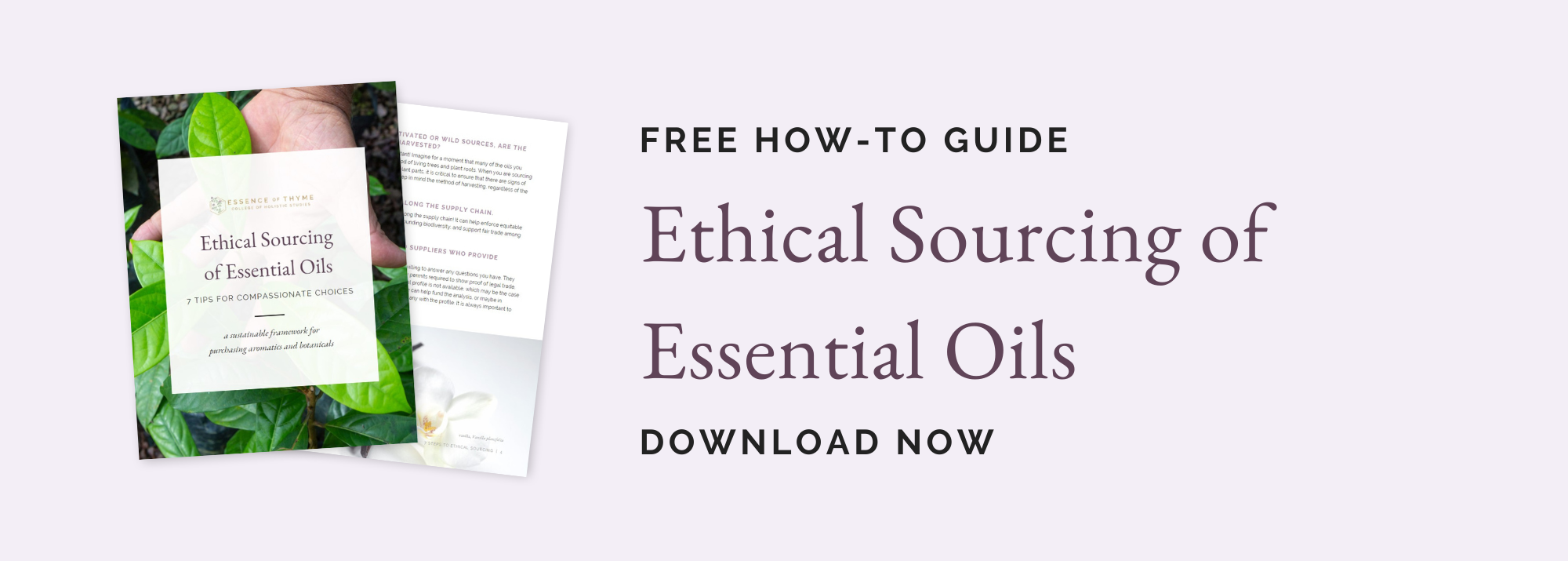Aromatherapy Meets Sustainability: How to Support Ethical Sourcing of Essential Oils

If you're reading this, odds are that you use essential oils and are mindful of the fragile state planet Earth is in. Thinking about just how fragile our planet truly is can leave you feeling overwhelmed and anxious; I know that is how I’m left feeling sometimes!
My relationship with essential oil-bearing plants is one I greatly value, especially as an aromatherapist - our planet is built upon the foundation of these types of balanced relationships with other species. They depend on us in part for their protection and preservation of resources, and we depend on them for food, clothing, shelter, and, of course, essential oils as a form of natural medicine.
Demand vs. Supply: the Consequences of Imbalance
Unfortunately, many interspecific relationships aren't nurtured properly. An imbalance occurs when the demand for a resource (e.g., plant material) far outweighs its supply. This is the point when we begin to damage harmonious relationships with species and with natural resources on Earth — often unconsciously.
When you buy rosewood (Aniba rosaeodora) essential oil from an unsustainable and illegal source, you may be contributing to the decline of the rosewood tree, a culturally important tree to the Peruvian Shipibo for its spiritual and sacred uses.
The high global demand for very profitable rosewood essential oil, which is extracted from its heartwood, is the main reason the tree is overharvested — and with no signs of regeneration, the supply is dwindling. Consequently, it has been categorized on the IUCN Red List as Endangered (Barstow, 2021).
As of 2022, approximately 16% of aromatic plant species traded on the world market are facing extinction (Airmid Institute, 2022). At least 7 plant species facing extinction primarily for their essential oils or other aromatic characteristics are agarwood (Aquilaria malaccensis and A. rostrata), rosewood (A. rosaeodora), Brazilian sassafras (Ocotea pretiosa syn. O. odorifera), linaloe (Bursera aloexylon), sandalwood (Santalum album), and massoy (Cryptocarya massoy).
Repairing Relationships: Sustainability Managed Essential Oils
How do we begin to repair our relationship with these threatened aromatic plants so that we can continue to use their essential oils without contributing further to their decline? Good news: there are many things we can do.
For example, we can do our best to ensure that the oils sourced from threatened plant species are sustainably managed through practices such as sustainable agriculture, a technique that integrates three main goals: 1) environmental health; 2) economic profitability; and 3) social and economic equity. By meeting these three goals, the practice of sustainable agriculture helps to ensure plants, including those which produce essential oils and carrier oils, will continue to meet the needs of present and future generations.
But sustainable agriculture is much more involved than just replanting a plant that was removed for distillation. There should, for example, be an in-depth understanding of a tree's biology so that it and its future offspring are healthy, strong, and viable. Without this level of knowledge, one might, for example, overlook the critical fact that sandalwood (Santalum spicatum) requires specific host trees for its nutrients throughout its development.
Organizations that are serious about preserving and protecting species for future generations work with local residents while also collaborating with biologists, farmers, environmentalists, geneticists, pedologists, hydrologists, chemical ecologists, distillers, and other specialists to create an ideal environment which closely simulates a plant's natural habitat, needs, and relationship to other species. For example, sustainable management of agarwood (Aquilaria spp.) requires an understanding of the relationship it has to fungus and that it must be wounded first to produce an aromatic resin.
Crop diversification, sustainable harvesting, organic techniques, high-quality water, efficient energy sources, efficient water use, soil management, chemical profiles, economic viability, research and development, diversified production opportunities, community outreach, and education are all important factors that are likely present in an ideal sustainable agriculture model (National Research Council Committee, 2010).
How to Ethically Source Essential Oils
Be wary of purchasing oils from suppliers who aren't transparent about their supply chain and sustainable practices. There are organizations like Dutjahn Sandalwood Oils who are dedicated to cultivated, harvesting, and distilling sandalwood (S. spicatum) through quality and comprehensive levels of sustainable management practices, such as sustainable agriculture, in collaboration with Indigenous communities. They provide a good model of what to look for in other companies that are committed to rebuilding a harmonious relationship with Nature.
Download our free guide, below, which will help you establish your framework for ethical sourcing of essential oils.
Taking these extra steps when ethically sourcing can help us protect this fragile planet, live and heal in harmony with Nature, and leave a plentiful supply of essential oils for future generations.

Stay up to date with Essence of Thyme and get new content delivered to your inbox.

Article by: Kelly Ablard, PhD, RA, MIFPA
Kelly has been a certified aromatherapy educator and conservation biologist for over 15 years. She is dedicated to the global education, research, and conservation of medicinal and aromatic plants. Kelly actively works to help protect and promote the uses of traditional medicine in Indigenous communities.
About Essence of Thyme College of Holistic Studies
Essence of Thyme College of Holistic Studies offers 300- and 630-hour professional aromatherapy certification programs that help you grow a successful, fulfilling career by specializing and creating your market niche. Professional Level Certification prepares graduates to become aromatherapy consultants, launch product lines or retail businesses, or provide services as an adjunct to existing holistic health specializations. Master Level Certification and electives are ideal for certified aromatherapists seeking higher education or a path to clinical aromatherapy practice.
All Essence of Thyme programs focus on aromatherapy product development and advanced formulation, evidence-based research, spa and business management, international industry regulatory guidelines, and sustainability and conservation of essential oil and carrier oil-bearing plants.
Our comprehensive, evidence-based programs meet or exceed the criteria set forth by 5 international professional aromatherapy associations. Learn more about our aromatherapy certification programs.
References
Ablard, K. (2022). Airmid Institute biannual list of threatened, near threatened, and CITES-protected plants, mammals, fungi, and seaweed species used in aromatherapy, perfumery, and aromatic herbalism. Airmid Institute. https://airmidinstitute.org/
Barstow, M. 2021. Aniba rosodora. The IUCN Red List of Threatened Species 2021: e.T33958A88301381. https://dx.doi.org/10.2305/IUCN.UK.2021-3.RLTS.T33958A88301381.en. Accessed on 21 February 2022.
National Research Council. (2010). Toward sustainable agricultural systems in the 21st century. The National Academies Press. https://doi.org/10.17226/12832


